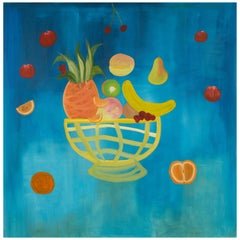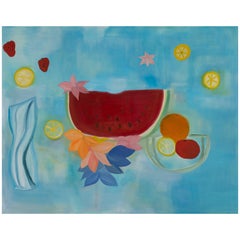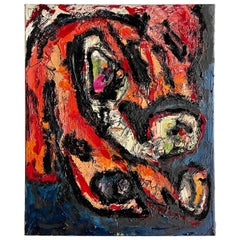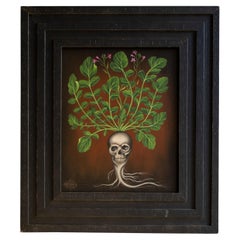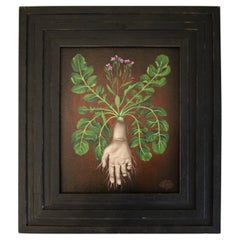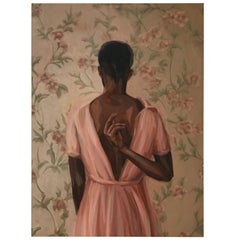2010s Paintings
to
117
467
321
444
417
Height
to
Width
to
262
37
11
4
3
2
2
1,319
3,674
12,825
2,739
1,707
4,670
4,161
185
111
324
479
418
656
1,101
1,141
644
530
430
360
286
222
193
424
346
323
67
62
861
823
844
23
15
15
14
12
Period: 2010s
Oil on Canvas Painting, "Los planetas frutales" by Paola Vega, Argentina, 2020
By Paola Vega
Located in Buenos Aires, Buenos Aires
Oil on canvas painting, "Los planetas frutales" by Paola Vega, Argentina, 2020
The painting was exhibited in her solo show "The life of paintings" at Calvaresi in Buenos Aires, 2020.
Paola Vega bio:
Paola Vega is an artist, researcher and curator. She graduated with a degree in History from the Universidad Nacional del Sur in 2003. In parallel, she began to study painting in Bahía Blanca at Espacio Vox with Gustavo López, and carried out work clinics with Jorge Gumier Maier and Diana Aisenberg between 2001 and 2002, and later in Buenos Aires with Pablo Siquier (2004) and Tulio de Sagastizábal (2005-2007). In 2003 she obtained a scholarship granted by the Antorchas Foundation to continue her training. She was selected to participate in the Artists Program of the Torcuato Di Tella University (2011) with tutoring from Jorge Macchi. In 2015 she did a residency in Madrid at El Prado...
Category
Argentine Modern 2010s Paintings
Materials
Paint
Oil on Canvas Painting, "La sandía suspendida" by Paola Vega, Argentina, 2020
By Paola Vega
Located in Buenos Aires, Buenos Aires
Oil on canvas Painting, "La sandía suspendida" by Paola Vega, Argentina, 2020
The painting was exhibited in her solo show "The life of paintings" at Calvaresi in Buenos Aires, 2020.
Paola Vega bio:
Paola Vega is an artist, researcher and curator. She graduated with a degree in History from the Universidad Nacional del Sur in 2003. In parallel, she began to study painting in Bahía Blanca at Espacio Vox with Gustavo López, and carried out work clinics with Jorge Gumier Maier and Diana Aisenberg between 2001 and 2002, and later in Buenos Aires with Pablo Siquier (2004) and Tulio de Sagastizábal (2005-2007). In 2003 she obtained a scholarship granted by the Antorchas Foundation to continue her training. She was selected to participate in the Artists Program of the Torcuato Di Tella University (2011) with tutoring from Jorge Macchi. In 2015 she did a residency in Madrid at El Prado...
Category
Argentine Modern 2010s Paintings
Materials
Paint
Original Black and Orange Abstract Oil Painting by Norman Liebman
Located in West Hartford, CT
Original abstract expressionist painting by Norman Liebman. Signed on back. Unframed.
Norman Liebman: Abstract Expressionist Painter, born in 1931 was a remarkable individual whose ...
Category
American Mid-Century Modern 2010s Paintings
Materials
Enamel
$1,260 Sale Price
30% Off
Contemporary Painting, Bestiary III, by Rubenimichi, Spain, 2020
Located in Madrid, ES
Contemporary painting, Bestiary I, by Spanish artists Rubenimichi, Acrylic on canvas, with a thick lacquered wood frame.
Measurements:
Painting: 21×27 (H) cm
Frame: 36 x 3.5 x ...
Category
Spanish 2010s Paintings
Materials
Canvas, Acrylic, Wood
Contemporary Painting, Bestiary III , by Rubenimichi, Spain, 2020
Located in Madrid, ES
Contemporary painting, First Motherland, by Spanish artists Rubenimichi, Acrylic on canvas, with a thick lacquered wood frame.
Measurements:
Painting: 21 x 27 cm
Frame: 36 x 3.5 x 4...
Category
Spanish 2010s Paintings
Materials
Canvas, Acrylic, Wood
Portrait of a Boy
Located in Schellebelle, BE
Portrait of a boy, Ismael
by Belgian painter Danny Cobbaut,
oil on canvas, 2016.
Category
Belgian 2010s Paintings
Materials
Paint
$4,135
Mixed Media Painting by Steven Colucci- My eyes on you
By Andrzej Galek
Located in New York City, NY
Steven Colucci’s iconoclastic approach to performance and the visual arts
have not only long blurred the boundaries between these disciplines, but have
challenged its most basic assumptions. The title of this show references a
most rudimentary dance move --the plié --and our assumptions of what to
expect in relation to this. Also the suggestion that we can simply press a
button and a preconceived outcome will be courteously delivered --a form of
prefabricated belief in itself. Steven Colucci’s artwork turns such basic
assumptions on their heads. Finding early inspiration in the New York school
of abstract expressionists such as Jackson Pollock with his action painting,
and then further by his professor --a then young Vito Acconci while studying
at the School of Visual Arts, Steven Colucci went from exploring the raw
existentialist experimentation of New York’s early painting and performance
scenes, to investigating the other end of the spectrum --the rigorously
measured and controlled disciplines of pantomime and ballet; studying in
Paris under the tutelage of world-famous Marcelle Marceau, and engaging
with the concepts of dramatic movement pioneer and intellectual Etienne
Decroux. Colucci has explained the difference between the extremes of
pantomime and dance as being that pantomime forces movement via an
internal capacity --movement directed inward to the core of one’s self --a
source requiring extreme mental and physical control. Dance by contrast is
an external expression; likewise requiring great precision, although instead
an extension of self or sentiment that projects outwardly. While such
historical ‘movement’ disciplines serve as foundation blocks for Steven’s
artistic explorations, it is the realm in between that he is best known for his
contributions --an experimental movement and performance art that
simultaneously honors, yet defiantly refutes tradition; rejecting a
compartmentalization regarding art and movement, yet incorporating its
elements into his own brand of experimental pastiche. Colucci’s performance
works manifest as eerily candy-coated and familiar, yet incorporate
unexpected jags of the uncanny throughout, exploiting a sort of coulrophobia
in the viewer; an exploration of a cumulative artifice that binds human
nature against its darker tendencies; highlighting traditions of artifice itself -
the fabricated systemologies that necessitate compartmentalization in the
first place.
It is evident in Steven Colucci’s paintings that he has established a uniquely
distinctive pictorial vocabulary; a strong allusion to --or moreso an extension
of --his performance works. Colucci’s paintings depict a sort of kinetic
spectrum, or as he refers to them “a technical expression of physicality and
movement”. Whereas the French performance and visual artist Yves Klein
used the human body as a “paint brush” to demarcate his paintings and
thereby signify a residue of performance, Colucci’s utilization of nonsensical
numbers and number sequences taken from dance scores, as well as heat-
induced image abstraction depicting traces of movement likewise inform his
vocabulary. In the strand of the choreographed, yet incorporating moments of
chance, Colucci’s paintings represent an over arching structure; a rhythm of
being and state, yet detail erratic moments --moments that denote a certain
frailty --the edge of human stamina. Colucci’s paintings dually represent a
form of gestural abstraction --and also the reverse of this --a unique
anthropomorphization of varying states of movement – that sometimes
present as a temperature induced color field, at others are juxtapositions of
movement and depictions of physical gestural images themselves. Colucci’s
use of vernacular and found materials such as cardboard evoke his mastery of
set design, and also reference a sort of collective experience of urbanity and
the ephemeral. Such contradictions seem to permeate not only Steven
Colucci’s artwork, but also are reflected in his person – one who grew up in
New York’s Bronx during a zeitgeist moment in visual and performing arts in
the 1960s – one who shifts with ease from happenings and experiments in
New York City, to his meticulously choreographed megaproductions at
Lincoln Center or starring in the Paris ballet...
Category
2010s Paintings
Materials
Acrylic
The Multidimensional Mind
By John Brevard
Located in Coral Gables, FL
In this painting by John Brevard, the theme of the work is nonduality, illustrating the concept that all things are interconnected and inseparable.
At the center of the painting, th...
Category
Spanish Space Age 2010s Paintings
Materials
Canvas, Acrylic
$15,000
Ugo La Pietra, " Genius Loci' " Acrylic on Canvas, 2009
Located in Milan, IT
Ugo La Pietra, " Genius Loci' " Acrylic on Canvas, 2009
Signed and Dated by Artist on front and rear.
Coded and Archived by Ugo La Pietra Archives.
Certificate of Authenticity a...
Category
Italian Post-Modern 2010s Paintings
Materials
Canvas
Ugo La Pietra, "Dal Giardino delle Delizie" Acrylic on Canvas, 2016
Located in Milan, IT
Ugo La Pietra, "Dal Giardino delle Delizie" acrylic on canvas, 2016
Signed and Dated by Artist on front and rear.
Coded and Archived by Ugo La Pietra Archives.
Certificate of Au...
Category
Italian Post-Modern 2010s Paintings
Materials
Canvas
Michelle Nussbaumer Original Painting "Corridor"
Located in Dallas, TX
Michelle Nussbaumer custom watercolor painting "Corridor" with a gold frame finish.
Featured in her collection with Wendover Art.
Category
2010s Paintings
Materials
Paint
akb_23_21, IT, 2023
Located in New York, NY
While visually maintaining a balance of chaos and control, Aurel K. Basedow’s paintings become a conversation between the rigid technical handling of resin, his chosen media, and the gestural possibilities of chromatic layering. Basedow most closely shares a kinship with 20th century painters like Mark Rothko, Sigmar Polke, Gerhard Richter, and Hermann Nitsch, whose paintings convey emotion and energy through physical and conceptual expression rather than realistic depiction or predetermined outcomes. Employing various mediums, the artist creates a vigorous composition of geometric lines and expressive brush strokes, with each gesture building on the previous one, separated by layers of clear resin. The use of multiple pigments and pouring techniques can create a fluid, dynamic appearance, with the colors mixing and blending together in unpredictable ways. Basedow leaves the edges of his paintings unrefined, revealing a visual history of each layered application. The use of resin also allows Basedow to incorporate unusual objects...
Category
Italian Modern 2010s Paintings
Materials
Resin, Wood, Paint
Price Upon Request
akb_23_16, IT, 2023
Located in New York, NY
While visually maintaining a balance of chaos and control, Aurel K. Basedow’s paintings become a conversation between the rigid technical handling of resin, his chosen media, and the gestural possibilities of chromatic layering. Basedow most closely shares a kinship with 20th century painters like Mark Rothko, Sigmar Polke, Gerhard Richter, and Hermann Nitsch, whose paintings convey emotion and energy through physical and conceptual expression rather than realistic depiction or predetermined outcomes. Employing various mediums, the artist creates a vigorous composition of geometric lines and expressive brush strokes, with each gesture building on the previous one, separated by layers of clear resin. The use of multiple pigments and pouring techniques can create a fluid, dynamic appearance, with the colors mixing and blending together in unpredictable ways. Basedow leaves the edges of his paintings unrefined, revealing a visual history of each layered application. The use of resin also allows Basedow to incorporate unusual objects...
Category
Italian Modern 2010s Paintings
Materials
Resin, Wood, Paint
Price Upon Request
akb_22_51, 2022
Located in New York, NY
While visually maintaining a balance of chaos and control, Aurel K. Basedow’s paintings become a conversation between the rigid technical handling of resin, his chosen media, and the gestural possibilities of chromatic layering. Basedow most closely shares a kinship with 20th century painters like Mark Rothko, Sigmar Polke, Gerhard Richter, and Hermann Nitsch, whose paintings convey emotion and energy through physical and conceptual expression rather than realistic depiction or predetermined outcomes. Employing various mediums, the artist creates a vigorous composition of geometric lines and expressive brush strokes, with each gesture building on the previous one, separated by layers of clear resin. The use of multiple pigments and pouring techniques can create a fluid, dynamic appearance, with the colors mixing and blending together in unpredictable ways. Basedow leaves the edges of his paintings unrefined, revealing a visual history of each layered application. The use of resin also allows Basedow to incorporate unusual objects...
Category
Italian Modern 2010s Paintings
Materials
Resin, Wood, Paint
Price Upon Request
Annie Morris, Untitled Peg Piece, 2010
By Annie Morris
Located in Hudson, NY
Using 1500 clothes pins to combine painting and sculpture to a dramatic affect is what artist Annie Morris is most famed for. Each peg is individually pai...
Category
British Modern 2010s Paintings
Materials
Wood, Paint
Price Upon Request
Portland White #1, USA
By Stefan Rurak
Located in New York, NY
Rurak’s Portland white paintings have a Minimalist confidence. Simple white boards are impulsively etched with groups of lines and forms familiar in his lexicon of imagery. The etchi...
Category
American 2010s Paintings
Materials
Concrete
Price Upon Request
Portland White #2, USA
By Stefan Rurak
Located in New York, NY
Rurak’s Portland White paintings have a minimalist confidence. Simple white boards are impulsively etched with groups of lines and forms familiar in his lexicon of imagery. The etchi...
Category
American 2010s Paintings
Materials
Concrete
Price Upon Request
Prairie, USA
By Stefan Rurak
Located in New York, NY
Brooklyn based Stefan Rurak’s unique vision and process stems from a diverse range of media, ranging from things as conventional as drawing and painting to performance art. “The work...
Category
American 2010s Paintings
Materials
Concrete, Cement, Sheet Metal
Price Upon Request
Console Diptych, USA
By Stefan Rurak
Located in New York, NY
Stefan Rurak’s credenza diptych typifies his unique approach to design. Rurak has translated his truism, denouncing the distinction between art and design, into a literal representat...
Category
American 2010s Paintings
Materials
Concrete, Cement, Steel
Price Upon Request
Drift Mirror, Sand and Mirror by Fernando Mastrangelo
Located in Brooklyn, NY
Through a layering of hand-dyed sand, the mirror consists of gradient tones and textures suggesting Patagonian glaciers breaking over water. The granules are stratified with nuance a...
Category
American 2010s Paintings
Materials
Mirror
Price Upon Request
Drift Mirror, Sand and Mirror by Fernando Mastrangelo
Located in Brooklyn, NY
Through a layering of hand-dyed sand, the mirror consists of gradient tones and textures suggesting Patagonian glaciers breaking over water. The granules are stratified with nuance a...
Category
American 2010s Paintings
Materials
Mirror
Price Upon Request
Recently Viewed
View AllMore Ways To Browse
Vienna Porcelain Cup
Vintage African Spears
Vintage Bombay Table
Vintage Brass Calendar
Vintage Bread Box
Vintage Brown Snuff Bottles
Vintage Cedar Jewelry Box
Vintage Cloisonne Ring
Vintage Enamel Teapot
Vintage Funk Furniture
Vintage Libbey Cocktail Glasses
Vintage Noritake Noritake
Vintage Umbrella Girl
Vintage Vinyl Record Storage Cabinet
Vintage Water Goblets
Vintage Whitefriars Glass Vase Whitefriars
Vintage Woven Rattan Chests
Virginia Chest Of Drawers
